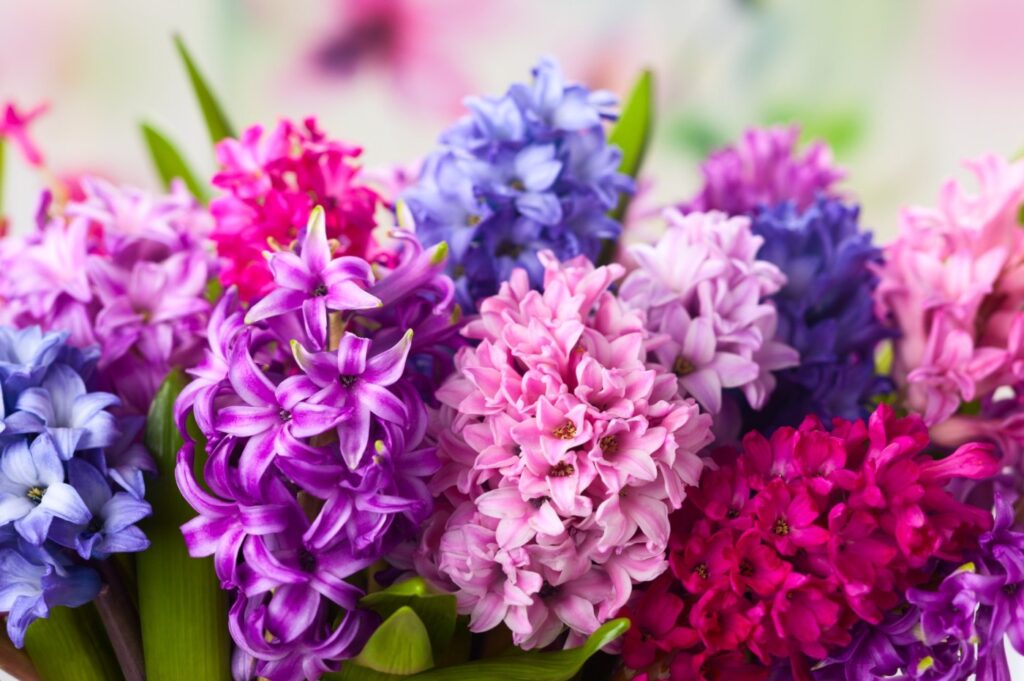
Five things to do in the garden this week:
1. Procure hyacinth bulbs now for “forcing,” a term that refers to causing a bulb to produce a flower before it normally would. Once you have your bulbs, put them in the refrigerator for 14 weeks and then place them in a shallow container with pebbles, adding water until it covers the pebbles. Alternatively, you can procure a special glass vase for forcing hyacinth bulbs that allows you to see the roots as they develop. Hyacinth flowers, appearing in blue, pink, yellow, red, or white, have a mesmerizing fragrance that migrates, filling the air around them. You can also acquire pre-cooled hyacinth bulbs – a bit pricier than the typical kind – at brentandbeckysbulbs.com, but you must plant them immediately or the pre-cooled effect will wear off.
2. Fall is for dividing perennials such as daylilies, naked ladies or belladonna lilies (Amaryllis belladonna), agapanthus, and Shasta daisies. In truth, this should not be regarded exclusively as a task undertaken to spread these plants into other parts of the garden, but also as an obligation if your desire is to keep these herbaceous perennials flowering at maximum capacity. Ground covers such as gazanias, arctotis, campanula, and rosea ice plant can also be separated into clumps and planted out during this time.
3. Fall is the time to plant leafy vegetables. Swiss chard will be ready to pick 50 days after sowing its seeds. This is a remarkably tough plant that will continue to grow for months; in our mild winter climate, it may persist for more than a year. This is achieved by harvesting a few outer leaves at a time from each individual plant. If you pick up a packet of chard seeds that are labeled Rainbow or Five Color Silverbeet, you will have chard whose petioles (leaf stems) and midribs (leaf midveins) are red, orange, yellow, pink, or white; leaves may be green, purple, or bronze. However, the most productive chard is white chard; it has thick white stems and broad green leaves. The name Swiss chard is a misnomer since the plant is of Mediterranean origin and was initially cultivated by the Greeks and Romans. However, it was scientifically classified by a Swiss botanist in the 1800s and that’s how it got its name.
Related Articles
Pumpkins, gourds and squash: They may be edible, but that doesn’t mean you’ll enjoy eating them
5 of the worst garden weeds and what you can (or can’t) do about them
Why these plants might be the toughest perennials of all
Why enclosed outdoor cat areas, or catios, might be what you and your pet need
Why gardeners should consider colorful flowers that bloom through the year
4. I recently asked readers to tell me about their favorite tree. Grace Hampton, who gardens in Burbank wrote as follows: “I like the Chinese pistache (Pistacia chinensis). It provides brilliant fall color. It is colorful i(bright green) in the spring when it leafs out. Its berries make it a feeding station for the birds.” I would add that it grows to a reasonable height of 30-50 feet with a canopy that spreads out to a similar extent. Fruit is red but eventually turns navy blue and, like all pistachio species, it is dioecious, meaning there are separate male and female trees. Thus, if you are not fond of the fruit, which some consider to be a nuisance, plant a male Chinese pistache. Fall, of course, is the best time to plant trees and other woody plants of all kinds.
5. This is the moment to plant California poppy and other wildflower seeds. In my backyard, under half-day sun conditions, I have seen California poppies in bloom since February. California poppies are supposed to stop flowering in the summer, but I have not found this to be true, at least where they are irrigated from time to time. I don’t mean to say that the same California poppy plants have been flowering continuously,and most of the early bloomers are dead, but the seeds they dropped germinated and developed into plants that began flowering in the summer, some of which are still blooming. It takes 60-90 days from planting California poppy seeds to see the first flowers bloom.
You can also send questions or comments about gardening practices or problems to [email protected].
